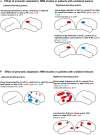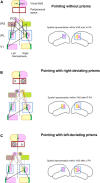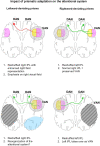Choosing Sides: Impact of Prismatic Adaptation on the Lateralization of the Attentional System
- PMID: 35814089
- PMCID: PMC9260393
- DOI: 10.3389/fpsyg.2022.909686
Choosing Sides: Impact of Prismatic Adaptation on the Lateralization of the Attentional System
Abstract
Seminal studies revealed differences between the effect of adaptation to left- vs. right-deviating prisms (L-PA, R-PA) in normal subjects. Whereas L-PA leads to neglect-like shift in attention, demonstrated in numerous visuo-spatial and cognitive tasks, R-PA has only minor effects in specific aspects of a few tasks. The paucity of R-PA effects in normal subjects contrasts with the striking alleviation of neglect symptoms in patients with right hemispheric lesions. Current evidence from activation studies in normal subjects highlights the contribution of regions involved in visuo-motor control during prism exposure and a reorganization of spatial representations within the ventral attentional network (VAN) after the adaptation. The latter depends on the orientation of prisms used. R-PA leads to enhancement of the ipsilateral visual and auditory space within the left inferior parietal lobule (IPL), switching thus the dominance of VAN from the right to the left hemisphere. L-PA leads to enhancement of the ipsilateral space in right IPL, emphasizing thus the right hemispheric dominance of VAN. Similar reshaping has been demonstrated in patients. We propose here a model, which offers a parsimonious explanation of the effect of L-PA and R-PA both in normal subjects and in patients with hemispheric lesions. The model posits that prismatic adaptation induces instability in the synaptic organization of the visuo-motor system, which spreads to the VAN. The effect is lateralized, depending on the side of prism deviation. Successful pointing with prisms implies reaching into the space contralateral, and not ipsilateral, to the direction of prism deviation. Thus, in the hemisphere contralateral to prism deviation, reach-related neural activity decreases, leading to instability of the synaptic organization, which induces a reshuffling of spatial representations in IPL. Although reshuffled spatial representations in IPL may be functionally relevant, they are most likely less efficient than regular representations and may thus cause partial dysfunction. The former explains, e.g., the alleviation of neglect symptoms after R-PA in patients with right hemispheric lesions, the latter the occurrence of neglect-like symptoms in normal subjects after L-PA. Thus, opting for R- vs. L-PA means choosing the side of major IPL reshuffling, which leads to its partial dysfunction in normal subjects and to recruitment of alternative or enhanced spatial representations in patients with hemispheric lesions.
Keywords: fMRI; prism-induced plasticity; review; spatial representation; ventral attentional network.
Copyright © 2022 Clarke, Farron and Crottaz-Herbette.
Conflict of interest statement
The authors declare that the research was conducted in the absence of any commercial or financial relationships that could be construed as a potential conflict of interest.
Figures




Similar articles
-
A Brief Exposure to Leftward Prismatic Adaptation Enhances the Representation of the Ipsilateral, Right Visual Field in the Right Inferior Parietal Lobule.eNeuro. 2017 Sep 27;4(5):ENEURO.0310-17.2017. doi: 10.1523/ENEURO.0310-17.2017. eCollection 2017 Sep-Oct. eNeuro. 2017. PMID: 28955725 Free PMC article.
-
Does hand modulate the reshaping of the attentional system during rightward prism adaptation? An fMRI study.Front Psychol. 2022 Jul 27;13:909815. doi: 10.3389/fpsyg.2022.909815. eCollection 2022. Front Psychol. 2022. PMID: 35967619 Free PMC article.
-
Supramodal effect of rightward prismatic adaptation on spatial representations within the ventral attentional system.Brain Struct Funct. 2018 Apr;223(3):1459-1471. doi: 10.1007/s00429-017-1572-2. Epub 2017 Nov 18. Brain Struct Funct. 2018. PMID: 29151115
-
Modulation of visual attention by prismatic adaptation.Neuropsychologia. 2016 Nov;92:31-41. doi: 10.1016/j.neuropsychologia.2016.06.022. Epub 2016 Jun 21. Neuropsychologia. 2016. PMID: 27342255 Review.
-
Bottom-up transfer of sensory-motor plasticity to recovery of spatial cognition: visuomotor adaptation and spatial neglect.Prog Brain Res. 2003;142:273-87. doi: 10.1016/S0079-6123(03)42019-0. Prog Brain Res. 2003. PMID: 12693267 Review.
Cited by
-
The Effect of Cognitive Style on Individual Differences in Prismatic Adaptation: A Pilot Study.Brain Sci. 2023 Apr 8;13(4):641. doi: 10.3390/brainsci13040641. Brain Sci. 2023. PMID: 37190606 Free PMC article.
-
Prismatic adaptation coupled with cognitive training as novel treatment for developmental dyslexia: a randomized controlled trial.Sci Rep. 2024 Mar 26;14(1):7148. doi: 10.1038/s41598-024-57499-9. Sci Rep. 2024. PMID: 38531968 Free PMC article. Clinical Trial.
-
Modulation of memory by prism adaptation in healthy subjects.Sci Rep. 2024 Oct 25;14(1):25358. doi: 10.1038/s41598-024-77027-z. Sci Rep. 2024. PMID: 39455697 Free PMC article.
References
Publication types
LinkOut - more resources
Full Text Sources
Miscellaneous

